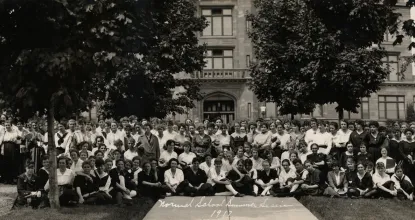By Abby LaForest
A Cosmic Introduction
The Upper Peninsula is a unique place for many reasons, and one that’s easy to miss is the sheer amount of stars that decorate our night skies. A lack of light pollution as you venture further into the U.P. wilderness leaves plenty of room for a viewer to look up and see celestial objects, constellations, and, with the help of some luck and knowledge of aurora forecasters, the northern lights. The sky above is one of many places for our imaginations and ambitions to run wild, with our interstellar existence fascinating the NMU community since the university’s beginnings.
Stellar Beginnings
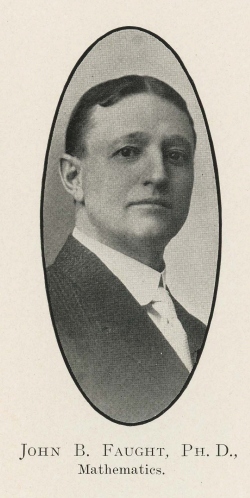
Northern’s first astronomy course was taught in the summer of 1907 by professor Dr. John Brookie Faught. As a 12-week-long descriptive course housed under the mathematics department, the course focused primarily on providing students with an overview of astronomical concepts, such as stars and the solar system, including any current knowledge of space at the time. The course continued to be offered to students following Dr. Faught’s departure from the university the following year. Over time, information covered in the university’s original singular astronomy class has been expanded into two courses - AS103 - Observational and Solar System Astronomy and AS104 - Stellar/Galactic Astronomy and Cosmology - to cover a wider breadth of material and accommodating growing knowledge of the universe that humans have encountered since the early twentieth century.
U.P. Resources of Planetary Proportions
Astronomy resources throughout the Upper Peninsula have expanded since Dr. Faught’s first class taught over a century ago, taking on the forms of programming, education, and physical spaces for both students and the public to enjoy. One of these includes the Shiras Planetarium located at the Marquette Senior High School, built in 1965 and named for George Shiras III, a national politician and naturalist/wildlife photographer. Funded by support from the National Defense Education Act, the planetarium originally acquired a Spitz A3P Optical-Mechanical class star projector to use and made its home within the local high school with assistance and funding from the Shiras Institute. Over the years, equipment has been repaired and replaced as needed, with the community group Friends of the Shiras Planetarium being founded in 2023 to fundraise for upgraded equipment and maintenance needs.
Dire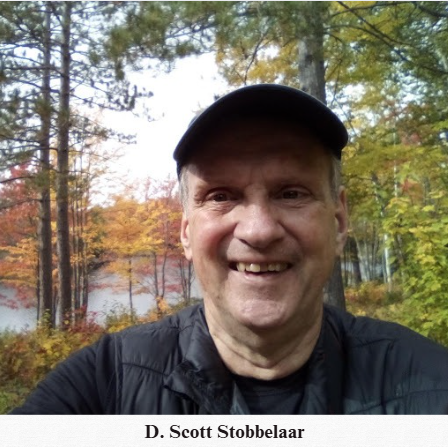 cting the Shiras Planetarium during its earlier stages was D. Scott Stobbelaar, a home-grown Yooper and Northern alumnus. Graduating with a Bachelor’s in Mathematics and Physics in 1972, Stobbelaar’s fascination with space began with the observation of Sputnik 1 in 1957, the first artificial Earth satellite launched into space by the former Soviet Union. This intrigue and wonder followed him throughout his childhood and adolescence, manifesting into projects that involved building his own telescopes, working on a laser project with former NMU physics department head Dr. Donald H. Baker in the 1960s, and founding the Marquette Astronomical Society. Following his discharge from service with the U.S. Navy, Stobbelaar became the planetarium’s director in July of 1973. Obtaining his teaching certificate from NMU in Math and Science, Stobbelaar also taught approximately 2 to 3 astronomy courses for high school students during his time as planetarium director, in addition to putting on astronomy shows for various school groups and community gatherings and spending his free time working on personal projects. His Master’s degree in Education, also received from NMU, focused on the time and dedication he channeled into his planetarium work, which evolved over the years into various other space-related opportunities.
cting the Shiras Planetarium during its earlier stages was D. Scott Stobbelaar, a home-grown Yooper and Northern alumnus. Graduating with a Bachelor’s in Mathematics and Physics in 1972, Stobbelaar’s fascination with space began with the observation of Sputnik 1 in 1957, the first artificial Earth satellite launched into space by the former Soviet Union. This intrigue and wonder followed him throughout his childhood and adolescence, manifesting into projects that involved building his own telescopes, working on a laser project with former NMU physics department head Dr. Donald H. Baker in the 1960s, and founding the Marquette Astronomical Society. Following his discharge from service with the U.S. Navy, Stobbelaar became the planetarium’s director in July of 1973. Obtaining his teaching certificate from NMU in Math and Science, Stobbelaar also taught approximately 2 to 3 astronomy courses for high school students during his time as planetarium director, in addition to putting on astronomy shows for various school groups and community gatherings and spending his free time working on personal projects. His Master’s degree in Education, also received from NMU, focused on the time and dedication he channeled into his planetarium work, which evolved over the years into various other space-related opportunities.
Stobbelaar found his way back to Northern by becoming an adjunct astronomy instructor for the physics department in 1996, where he taught astronomy lectures and labs for AS103 and AS104. The lab allowed students to use data collected by astronomers to calculate distances to far-off galaxies and the size of interstellar objects. After retiring from his position at the Shiras Planetarium, Stobbelaar became a STARLAB Specialist for the Glenn T. Seaborg Science and Mathematics Center in 2002, where he traveled across the Upper Peninsula to deliver astronomy presentations to students in K-12 schools using an inflatable STARLAB Portable Planetarium. He’s also the NASA Solar System Ambassador for Marquette and has been since 2004, giving many public presentations about various galactic topics throughout the years. Though now fully retired, Stobbelaar remains active in the Marquette Astronomical Society and his love for space is a permanent fixture in his life.
Earth to Northern! The University and Space Education
Since the introduction of astronomy to the university, Northern has seen space knowledge expand into other parts of the Upper Peninsula and items added to its educational resources. The Lloyd H. Sprinkle Observatory also makes its home on campus. The donation was 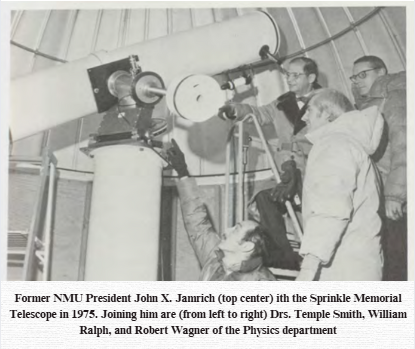 coordinated by former NMU physics assistant professors Dr. Temple Smith and Dr. William Ralph, along with former physics department head Dr. Robert Wagner, who secured the Newtonian telescope’s donation from Sprinkle’s wife Nell in late 1972. Sprinkle himself handcrafted the mirror installed on a 12-inch reflecting telescope. NMU purchased a dome from the Ash Dome Company in 1974 to encompass it, and the observatory was finally ready for use beginning in 1975. Lloyd Sprinkle, well-known in his field for optics development, had also donated to the Mount Wilson Observatory in California, the Massachusetts Institute of Technology, and the University of Michigan-Ann Arbor, where Sprinkle acted on behalf of the Astronomical Society of Northwest Detroit.
coordinated by former NMU physics assistant professors Dr. Temple Smith and Dr. William Ralph, along with former physics department head Dr. Robert Wagner, who secured the Newtonian telescope’s donation from Sprinkle’s wife Nell in late 1972. Sprinkle himself handcrafted the mirror installed on a 12-inch reflecting telescope. NMU purchased a dome from the Ash Dome Company in 1974 to encompass it, and the observatory was finally ready for use beginning in 1975. Lloyd Sprinkle, well-known in his field for optics development, had also donated to the Mount Wilson Observatory in California, the Massachusetts Institute of Technology, and the University of Michigan-Ann Arbor, where Sprinkle acted on behalf of the Astronomical Society of Northwest Detroit.
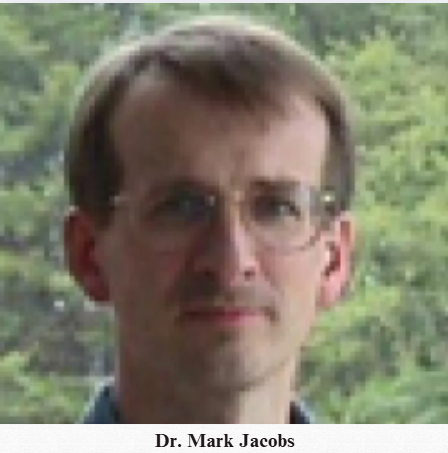
Current NMU physics professor Dr. Mark Jacobs, alongside emeritus professor Dr. Duane Fowler, had designed and specified the necessary equipment to build a replacement observatory telescope following the Sprinkle scope’s retirement from operations, an event coinciding with the Science Building’s renovations from 2000-2001. The newer scope sits on a mount welded in 2010 by Dr. Cale Polkinghorn of the engineering technology department on campus, with the Sprinkle scope retired and stored in the Science Building. While the observatory is no longer used for classroom instruction, the building remains a testament to Northern’s legacy of looking toward the stars.
Dr. Jacobs, a Marquette native who received his Ph.D. in cosmology and general relativity, uses miniature telescope kits in the classes he teaches, which replicate similar calibrations to the larger telescope. He’s been instructing astronomy classes and lab sections since being hired at Northern in 1996, where students from a variety of academic disciplines continue 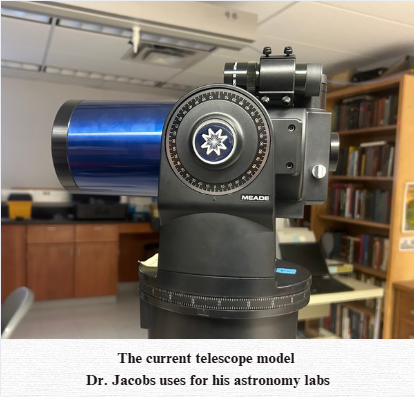 to learn about the skies beyond our home on Earth. One of Dr. Jacobs’ favorite parts about teaching the courses is being able to meet students where they’re at on their journeys and the enthusiasm that they bring to the table when in the classroom or lab setting. Dr. David Donovan, current department head of the physics department at NMU, also briefly discussed his past experiences with teaching astronomy courses. He’s previously covered topics ranging from the history of astronomy, properties of stars, misconceptions about the Big Bang “exploding” to create the universe, and the science behind the solar system. A member of Northern’s physics faculty since 1992, Dr. Donovan enjoyed the different approaches that students took to astronomy, including their observations and opinions, as well as his interest in the subject matter.
to learn about the skies beyond our home on Earth. One of Dr. Jacobs’ favorite parts about teaching the courses is being able to meet students where they’re at on their journeys and the enthusiasm that they bring to the table when in the classroom or lab setting. Dr. David Donovan, current department head of the physics department at NMU, also briefly discussed his past experiences with teaching astronomy courses. He’s previously covered topics ranging from the history of astronomy, properties of stars, misconceptions about the Big Bang “exploding” to create the universe, and the science behind the solar system. A member of Northern’s physics faculty since 1992, Dr. Donovan enjoyed the different approaches that students took to astronomy, including their observations and opinions, as well as his interest in the subject matter.
Though the observatory is no longer in operation, Northern’s additional resources still provide education and opportunity to the campus and wider Upper Peninsula communities. The Glenn T. Seaborg Science and Mathematics Center is a STEM-focused education and professional development facility connected to the Science Building on campus. Chris Standerford, current director of the Seaborg Center and the Central Upper Peninsula MiSTEM Region, was D. Scott Stobbelaar’s successor as director of the Shiras Planetarium before Standerford’s move to the Seaborg Center. Under his leadership, the center provides students and educators across the Upper Peninsula access to various STEM materials.
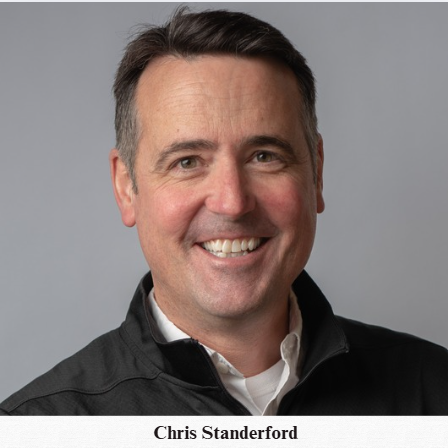
Since 1998, the NASA Glenn Research Center in Cleveland, Ohio has distributed resources to the Seaborg Center as part of their Resource Distribution Network, before switching to entirely digital artifacts due to funding reallocations in 2015. During that time, the center had a room outfitted to showcase some of the NASA materials in a gallery format, with a majority of the resources now available online. Today, the Center focuses mostly on STEM education, with projects including K-12 outreach programs for students in the area and professional development opportunities for teachers. The center also has portable STARLABs available for rental, and provides opportunities for those involved with the NASA Solar System Ambassadors Program to share their findings, a program where Standerford has been the designated ambassador for Negaunee since 2014.
Northern has also served as a gathering place for community members to experience two 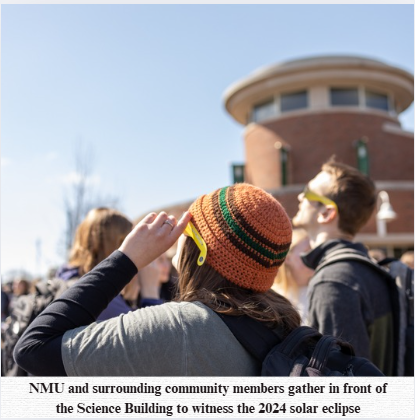 solar eclipses, where viewers were able to watch the moon pass over the sun and as it cast a shadow onto Earth. The first, occurring in August 2017, had attendees safely watch the eclipse through a telescope equipped with a sun filter in the observatory dome. Most recently, an eclipse took place in March 2024, with a collaboration between the Physics department and the Seaborg Center supplying onlookers with special eclipse glasses to protect their eyes while enjoying the cosmic event. While there is no determined time as to when the next eclipse will occur in the Upper Peninsula, it’s safe to anticipate similar enthusiasm for whatever may come in Northern’s stellar future.
solar eclipses, where viewers were able to watch the moon pass over the sun and as it cast a shadow onto Earth. The first, occurring in August 2017, had attendees safely watch the eclipse through a telescope equipped with a sun filter in the observatory dome. Most recently, an eclipse took place in March 2024, with a collaboration between the Physics department and the Seaborg Center supplying onlookers with special eclipse glasses to protect their eyes while enjoying the cosmic event. While there is no determined time as to when the next eclipse will occur in the Upper Peninsula, it’s safe to anticipate similar enthusiasm for whatever may come in Northern’s stellar future.
To Infinity and Beyond: NMU in Space
While a lot of Northern’s space exploration has been done from the ground, there have been a few artifacts that have made their way past the Earth’s atmosphere, including an NMU flag. In 1996, NASA astronaut Jerry Linenger contacted then-university president Dr. William Vandament to see if any NMU materials could be brought with him on his next space mission. Consulting with Dr. Russell Magnaghi, the university’s historian, a 1962 note made in the State Board of Education 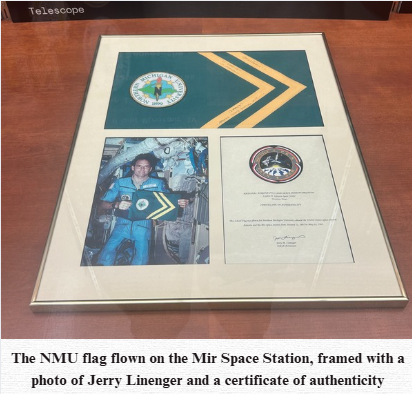 Minutes requesting approval of the college flag was discovered, which prompted Dr. Magnaghi to then get into contact with Kevin Sheard, the original designer of the flag. The NMU flag was taken into space with Linenger and his crew on the United States Space Shuttle Atlantis to the Russian space station Mir, where it remained from January 1997 to May 1997 on NASA missions STS-81 and STS-84. The August 28th, 1997 edition of the North Wind celebrates Linenger’s return to Northern with the flag, when nearly 250 people gathered in the University Center’s (now known as the Northern Center) Great Lakes Rooms to hear Linenger speak about his time in space. The actual NMU flag, along with a photo of Jerry Linenger holding it on the Mir, and a certificate of authenticity from NASA’s Lyndon B. Johnson Space Center in Houston, are housed for display within the Science Building on Northern’s campus.
Minutes requesting approval of the college flag was discovered, which prompted Dr. Magnaghi to then get into contact with Kevin Sheard, the original designer of the flag. The NMU flag was taken into space with Linenger and his crew on the United States Space Shuttle Atlantis to the Russian space station Mir, where it remained from January 1997 to May 1997 on NASA missions STS-81 and STS-84. The August 28th, 1997 edition of the North Wind celebrates Linenger’s return to Northern with the flag, when nearly 250 people gathered in the University Center’s (now known as the Northern Center) Great Lakes Rooms to hear Linenger speak about his time in space. The actual NMU flag, along with a photo of Jerry Linenger holding it on the Mir, and a certificate of authenticity from NASA’s Lyndon B. Johnson Space Center in Houston, are housed for display within the Science Building on Northern’s campus.
Northern graduates also use their education to do impressive work for space, with Kall Morris Inc. being a local example. The Marquette-based space logistics startup specializes in sustainable orbital operations, using its relocation services to extend/enhance the life of current space missions and properly relocate man-made space material that has reached the end of its lifespan. Two of the three co-founders, Adam Kall, KMI’s Director of Science, and Austin Morris, Director of Engineering, were freshman-year roommates in Van Antwerp Hall during their time at NMU. Along with many of their employees, they had studied and enjoyed the guidance of Mathematics and Computer Science professor Dr. Jeffrey Horn, who passed away in 2024. Following Kall and Morris’ brief educational/professional stints in New York City and Philadelphia respectively, the business was launched (no pun intended) with the help of the third co-founder and fellow NMU graduate, Austin’s brother Troy, who also serves as KMI’s Chief Executive Officer. As for location, deciding to open the business in the Marquette area was especially important to the co-founders, as their sustainability mission aligns directly with environmental advocacy in the Upper Peninsula.
As of this article’s publication, KMI’s flagship spacecraft is Laelaps, a name pulled from Greek mythology that describes a hound notorious for catching everything he chased. The spacecraft is a combination of technologies, including software designed to measure the rotation 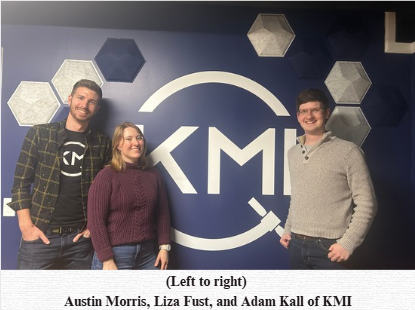 of debris in orbit and hardware to manage the collection of space debris. This hardware, dubbed REACCH, was tested in the International Space Station on November 15th, 2024, just one week before the company’s fifth anniversary on November 22nd. While mishandled space junk not only clutters up the skies and also interferes with astronomical study, KMI works with customers and collaborators to ensure that the skies beyond our world become clear of materials promptly, as the environment of space doesn’t allow for much waiting around. After working through the research stage and figuring out how to combat the potential cascading disasters that can come from unattended space debris, Kall described how their current development phase doesn’t see their missions as unsolvable problems, but rather practical ones.
of debris in orbit and hardware to manage the collection of space debris. This hardware, dubbed REACCH, was tested in the International Space Station on November 15th, 2024, just one week before the company’s fifth anniversary on November 22nd. While mishandled space junk not only clutters up the skies and also interferes with astronomical study, KMI works with customers and collaborators to ensure that the skies beyond our world become clear of materials promptly, as the environment of space doesn’t allow for much waiting around. After working through the research stage and figuring out how to combat the potential cascading disasters that can come from unattended space debris, Kall described how their current development phase doesn’t see their missions as unsolvable problems, but rather practical ones.
Kall Morris Inc. not only dedicates the talents of its team to projects beyond Earth’s surface but also makes an effort to give back and engage with the community on their home turf. As KM’s Director of Operations, Liza Fust (who is also a former Beaumier U.P. Heritage Center student assistant and met Austin through an undergraduate fencing class, long before KMI,) has a platform to educate the public and show students the endless possibilities when it comes to space careers. From participating in space and science, technology, engineering, arts, and mathematics (STEAM) education events across the Upper Peninsula to helping STEM and space efforts locally, and engaging with NMU events such as the Three-Minute Thesis and Presidential Scholars Competitions, KMI works to inspire and educate the public about the wonders of space. They also work with K-12 students, aiming to emphasize the importance of the arts and humanities in the space industry (and Fust, with her English background, is one of their employees who provides proof of this success!) The environment of KMI values everyone’s skills and personhood, and anyone interested is always encouraged to reach out to them.
Conclusion: Astronomic Potential
The story of Northern’s engagement with Upper Peninsula astronomy is ever-developing and far from over, as vast and immersive as the universe itself. Dr. Faught’s introduction of an astronomy course to the university was just the beginning, and over a century later, both the Wildcat and Yooper communities have collaborated to brighten the night skies closer to Earth through education, architecture, and technological advancements. While the methods and logistics of these approaches may differ, there’s a love of worlds beyond and a deeper appreciation for the one we live in now that binds it all together. Perhaps NMU’s next step will be establishing a constellation of Wildcat Willy, so make sure to watch out for him the next time you gaze up into the night sky.
